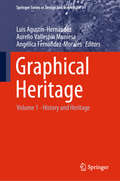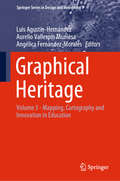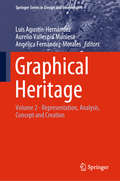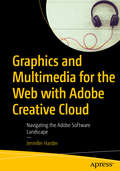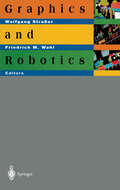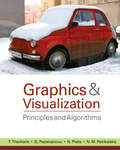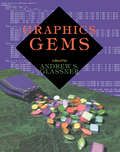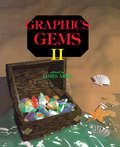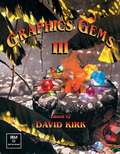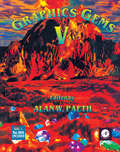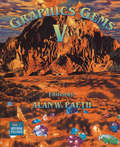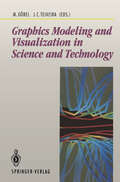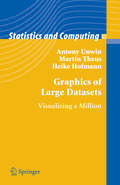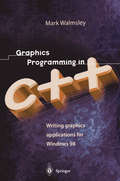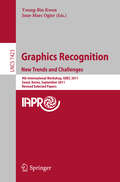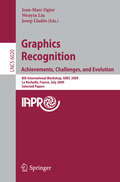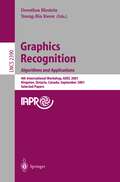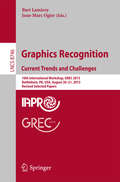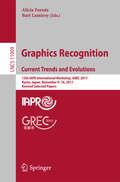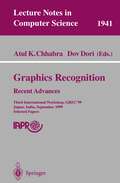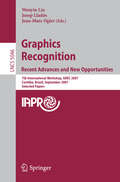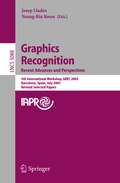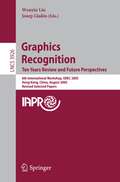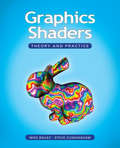- Table View
- List View
Graphical Heritage: Volume 1 - History and Heritage (Springer Series in Design and Innovation #5)
by Luis Agustín-Hernández Aurelio Vallespín Muniesa Angélica Fernández-MoralesThis book presents the proceedings of the 18th International Conference on Graphic Design in Architecture, EGA 2020, focusing on heritage – including architectural and graphic heritage as well as the graphics of heritage. This first volume gathers selected contributions covering theories, and new technologies and findings to help shed light on current questions related to heritage. It features original documentation studies on historical archives, 3D and solid representation of architectural objects, as well as virtual graphic representation and applications of augmented reality, all documenting and/or reconstructing the present, past and future of architectural objects. As such, this book offers extensive and timely information to architectural and graphic designers, urban designers and engineers, and industrial designers and historians.
Graphical Heritage: Volume 3 - Mapping, Cartography and Innovation in Education (Springer Series in Design and Innovation #7)
by Luis Agustín-Hernández Aurelio Vallespín Muniesa Angélica Fernández-MoralesThis book presents the proceedings of the 18th International Conference on Graphic Design in Architecture, EGA 2020, focusing on heritage – including architectural and graphic heritage as well as the graphics of heritage. The third of three volumes, this book discusses topics related to mapping, cartography and landscape, as well as innovative education methods, particularly in the context of teaching architectural heritage. It covers historical cartography and new cartographies, as well as methods for representing the landscape, and reports on different learning methods and practices, including classroom methods but also those involving more active participation and multidisciplinary and collaborative production. Given its scope, this book will appeal cartographers, designers and teachers, providing them with extensive information on innovative methodologies and a source of inspiration for their future work.
Graphical Heritage: Volume 2 - Representation, Analysis, Concept and Creation (Springer Series in Design and Innovation #6)
by Luis Agustín-Hernández Aurelio Vallespín Muniesa Angélica Fernández-MoralesThis book presents the proceedings of the 18th International Conference on Graphic Design in Architecture, EGA 2020, focusing on heritage – including architectural and graphic heritage as well as the graphics of heritage. Consisting of two parts: “Representation and Analysis” and “Concept and Creation”, this second volume gathers selected contributions on topics ranging from graphic representation to the graphic presentation of ideas, i.e. artistic creation, to bridge the gap between graphic heritage and the graphics of heritage. Given its scope, this volume will appeal to architectural and graphic designers, artists and engineers, providing them with extensive information on new methods and a source of inspiration for future research and interdisciplinary collaborations.
Graphics and Multimedia for the Web with Adobe Creative Cloud: Navigating the Adobe Software Landscape
by Jennifer HarderUpgrade your skills in Adobe Creative Cloud and enhance your corporate or personal website with multimedia and graphics. In this book you'll look at the latest versions of five core Adobe programs: Photoshop, Illustrator, Animate (formerly Flash), Media Encoder and Dreamweaver. As you work with each of these programs to create images, animations, audio and video you will see how each one can help you complete and finally integrate your multimedia files into a final mobile friendly website.Adding new multimedia features to your website does not have to be difficult or confusing. If you plan your route and goals correctly, along the way you will see how each software has its own use, but ultimately, how they can all work together for a common goal. This book also shows you how additional Creative Cloud software can be used with the core five programs should you want to add further interactivity.What You'll Learn:Use Adobe Creative Cloud software to create graphics and multimedia for a websiteRender images in various formatsWork with video, HTML5 Canvas and audio files for the websiteDiscover new features of HTML5 and CSS3 and how to work with them in Dreamweaver CCWho This Book Is ForGraphic designers who are creating websites; students in the classroom; instructors wanting to upgrade their Adobe Creative Cloud skills.
Graphics and Robotics
by Wolfgang Straßer Friedrich M. WahlProblems common to graphics and robotics are covered in this reviewed selection of papers written following a 1993 workshop. Leading experts from both disciplines met to identify common problems, to present new solutions, and to discuss future research directions. Topics covered include robot simulation using graphics workstations, simulation concepts in the framework of teleoperation, path planning strategies, collision detection techniques, experimentation using virtual reality, modeling techniques for automated programming and for objects with curved surfaces, object-oriented implementations, various aspects of robot vision, and - in a paper that reflects the essence of the workshop - the challenging task of designing a vision system for a domestic robot.
Graphics and Visualization: Principles & Algorithms
by T. TheoharisThis book is a comprehensive introduction to visual computing, dealing with the modeling and synthesis of visual data by means of computers. What sets this book apart from other computer graphics texts is the integrated coverage of computer graphics and visualization topics, including important techniques such as subdivision and multi-resolution mo
Graphics Gems (Graphics Gems - IBM)
by Andrew S. Glassner"The GRAPHICS GEMS Series" was started in 1990 by Andrew Glassner. The vision and purpose of the Series was - and still is - to provide tips, techniques, and algorithms for graphics programmers. All of the gems are written by programmers who work in the field and are motivated by a common desire to share interesting ideas and tools with their colleagues. Each volume provides a new set of innovative solutions to a variety of programming problems.
Graphics Gems II (Graphics Gems - IBM)
by James ArvoGraphics Gems II is a collection of articles shared by a diverse group of people that reflect ideas and approaches in graphics programming which can benefit other computer graphics programmers.This volume presents techniques for doing well-known graphics operations faster or easier. The book contains chapters devoted to topics on two-dimensional and three-dimensional geometry and algorithms, image processing, frame buffer techniques, and ray tracing techniques. The radiosity approach, matrix techniques, and numerical and programming techniques are likewise discussed.Graphics artists and computer programmers will find the book invaluable.
Graphics Gems III: Ibm Version (Graphics Gems - IBM)
by David KirkThis sequel to Graphics Gems (Academic Press, 1990), and Graphics Gems II (Academic Press, 1991) is a practical collection of computer graphics programming tools and techniques. Graphics Gems III contains a larger percentage of gems related to modeling and rendering, particularly lighting and shading. This new edition also covers image processing, numerical and programming techniques, modeling and transformations, 2D and 3D geometry and algorithms,ray tracing and radiosity, rendering, and more clever new tools and tricks for graphics programming. Volume III also includes a disk containing source codes for either the IBM or Mac versions featuring all code from Volumes I, II, and III. Author David Kirk lends his expertise to the Graphics Gems series in Volume III with his far-reaching knowledge of modeling and rendering, specifically focusing on the areas of lighting and shading. Volume III includes a disk containing source codes for both the IBM and Mac versions featuring all code from volumes I, II, and III. Graphics Gems I, II, and III are sourcebooks of ideas for graphics programmers. They also serve as toolboxes full of useful tricks and techniques for novice programmers and graphics experts alike. Each volume reflects the personality and particular interests of its respective editor.Includes a disk containing source codes for both the IBM and Mac versions featuring code from volumes I, II, and IIIFeatures all new graphics gemsExplains techniques for making computer graphics implementations more efficientEmphasizes physically based modeling, rendering, radiosity, and ray tracingPresents techniques for making computer graphics implementations more efficient
Graphics Gems IV (The Morgan Kaufmann Series in Computer Graphics)
by Paul HeckbertGraphics Gems IV is the newest volume in the Graphics Gems series. All of the books in the series contain practical solutions for graphics problems using the latest techniques in the field. The books in this series have become essential, time saving toolsfor many programmers. Volume IV is a collection of carefully crafted gems which are all new and innovative. All of the gems are immediately accessible and useful in formulating clean, fast, and elegant programs. The C programming language has been used for most of the program listings, although several of the gems have C++ implementations. *IBM version Includes one 3 1/2" high-density disk. System Requirements: 286 or higher IBM PC compatible, DOS 4.0 or higher
Graphics Gems V (Graphics Gems - Macintosh)
by Alan W. PaethGraphics Gems V is the newest volume in The Graphics Gems Series. It is intended to provide the graphics community with a set of practical tools for implementing new ideas and techniques, and to offer working solutions to real programming problems. These tools are written by a wide variety of graphics programmers from industry, academia, and research. The books in the series have become essential, time-saving tools for many programmers.Latest collection of graphics tips in The Graphics Gems Series written by the leading programmers in the field.Contains over 50 new gems displaying some of the most recent and innovative techniques in graphics programming.Includes gems covering ellipses, splines, Bezier curves, and ray tracing.Disk included containing source code from the gems available in both IBM and Macintosh versions.
Graphics Gems V (The Morgan Kaufmann Series in Computer Graphics)
by Alan W. PaethGraphics Gems V is the newest volume in The Graphics Gems Series. It is intended to provide the graphics community with a set of practical tools for implementing new ideas and techniques, and to offer working solutions to real programming problems. These tools are written by a wide variety of graphics programmers from industry, academia, and research. The books in the series have become essential, time-saving tools for many programmers.Latest collection of graphics tips in The Graphics Gems Series written by the leading programmers in the fieldContains over 50 new gems displaying some of the most recent and innovative techniques in graphics programmingIncludes gems covering ellipses, splines, Bezier curves, and ray tracing
Graphics Modeling and Visualization in Science and Technology: in Science and Technology (Beiträge zur Graphischen Datenverarbeitung)
by José C. Teixeira Martin GöbelGraphics of Large Datasets: Visualizing a Million (Statistics and Computing)
by Antony Unwin Martin Theus Heike HofmannThis book shows how to look at ways of visualizing large datasets, whether large in numbers of cases, or large in numbers of variables, or large in both. All ideas are illustrated with displays from analyses of real datasets and the importance of interpreting displays effectively is emphasized. Graphics should be drawn to convey information and the book includes many insightful examples. New approaches to graphics are needed to visualize the information in large datasets and most of the innovations described in this book are developments of standard graphics. The book is accessible to readers with some experience of drawing statistical graphics.
Graphics Programming in C++: Writing Graphics Applications for Windows 98
by Mark WalmsleyA quick and clear introduction to graphics programming under Windows 98 without encumbering the reader in a mass of extraneous details. The application of object oriented techniques to graphics programming is a principal theme throughout the text and many illustrative coding examples in C++ are provided. The main topics include: message-based programming; window management; working with C++ objects; Windows 98 GDI; pens, brushes, bitmaps and palettes; sprite animation; wire-frame and polygon-fill images; assembly language programming; 3D vector geometry; perspective projections; hidden pixel removal; colour shading and texture mapping; virtual world simulation.
Graphics Recognition: New Trends and Challenges (Lecture Notes in Computer Science #7423)
by Young-Bin Kwon Jean-Marc OgierThis book constitutes the thoroughly refereed post-conference proceedings of the 9th International Workshop on Graphics Recognition (GREC 2011), held in Seoul, Korea, September 15-16, 2011. The 25 revised full papers presented were carefully selected from numerous submissions. Graphics recognition is a subfield of document image analysis that deals with graphical entities in engineering drawings, sketches, maps, architectural plans, musical scores, mathematical notation, tables, and diagrams. Accordingly the conference papers are organized in 5 technical sessions, covering the topics such as map and ancient documents, symbol and logo recognition, sketch and drawings, performance evaluation and challenge processing.
Graphics Recognition: 8th International Workshop, GREC 2009, La Rochelle, France, July 22-23, 2009, Selected Papers (Lecture Notes in Computer Science #6020)
by Jean-Marc Ogier Wenyin Liu Josep LladosThis book contains refereed and improved papers presented at the 8th IAPR Workshop on Graphics Recognition (GREC 2009), held in La Rochelle, France, July 22–23, 2009. The GREC workshops provide an excellent opportunity for researchersand practitionersat all levels of experience to meet colleaguesand to share new ideas and knowledge about graphics recognition methods. Graphics recognition is a sub?eld of document image analysis that deals with graphical entities in engineering drawings, sketches, maps, architectural plans, musical scores, mathematical notation, tables, diagrams, etc. GREC 2009 continued the tradition of past workshops held in the Penn State University, USA (GREC 1995, LNCS Volume 1072, Springer Verlag, 1996); Nancy, France (GREC 1997, LNCS Volume 1389, Springer Verlag, 1998); Jaipur, India (GREC 1999, LNCS Volume 1941, Springer Verlag, 2000); Kingston, Canada (GREC 2001, LNCS Volume 2390, Springer Verlag, 2002); Barcelona, Spain (GREC 2003, LNCS Volume 3088, Springer Verlag, 2004); Hong Kong, China (GREC 2005, LNCS Volume 3926, Springer Verlag, 2006); and (GREC 2007, LNCS Volume 5046, Springer Verlag, 2008). The programof GREC 2009 was organized in a single-track 2-day workshop. It comprised several sessions dedicated to speci?c topics. For each session, there was an invited presentation describing the state of the art and stating the open questions for the session’s topic, followed by a number of short presentations thatcontributedbyproposingsolutionstosomeofthequestionsorbypresenting results ofthe speaker’swork. Eachsessionwas then concludedby a paneldisc- sion.
Graphics Recognition. Algorithms and Applications: 4th International Workshop, GREC 2001, Kingston, Ontario, Canada, September 7-8, 2001. Selected Papers (Lecture Notes in Computer Science #2390)
by Dorothea Blostein Young-Bin KwonThis book presents refereed and revised papers presented at GREC 2001, the 4th IAPR International Workshop on Graphics Recognition, which took place in Kingston, Ontario, Canada in September 2001. Graphics recognition is a branch of document image analysis that focuses on the recognition of two-dimensional notations such as engineering drawings, maps, mathematical notation, music notation, tables, and chemical structure diagrams. Due to the growing demand for both o?-line and on-line document recognition systems, the ?eld of graphics recognition has an excitingand promisingfuture. The GREC workshops provide an opportunity for researchers at all levels of experience to share insights into graphics recognition methods. The workshops enjoy strongparticipation from researchers in both industry and academia. They are sponsored by IAPR TC-10, the Technical Committee on Graphics Recog- tion within the International Association for Pattern Recognition. Edited v- umes from the previous three workshops in this series are available as Lecture Notes in Computer Science, Vols. 1072, 1389, and 1941. After the GREC 2001 workshop, authors were invited to submit enhanced versions of their papers for review. Every paper was evaluated by three reviewers. We are grateful to both authors and reviewers for their careful work during this review process. Many of the papers that appear in this volume were thoroughly revised and improved, in response to reviewers’ suggestions.
Graphics Recognition. Current Trends and Challenges: 10th International Workshop, GREC 2013, Bethlehem, PA, USA, August 20-21, 2013, Revised Selected Papers (Lecture Notes in Computer Science #8746)
by Bart Lamiroy Jean-Marc OgierThis book constitutes the thoroughly refereed post-conference proceedings of the 10th International Workshop on Graphics Recognition, GREC 2013, held in Bethlehem, PA, USA, in August 2013.The 20 revised full papers presented were carefully reviewed and selected from 32 initial submissions. Graphics recognition is a subfield of document image analysis that deals with graphical entities in engineering drawings, sketches, maps, architectural plans, musical scores, mathematical notation, tables, and diagrams. Accordingly the conference papers are organized in 5 topical sessions on symbol spotting and retrieval, graphics recognition in context, structural and perceptual based approaches, low level processing, and performance evaluation and ground truthing.
Graphics Recognition. Current Trends and Evolutions: 12th Iapr International Workshop, Grec 2017 Kyoto, Japan, November 9-10, 2017, Revised Selected Papers (Lecture Notes in Computer Science #11009)
by Alicia Fornés Bart LamiroyThis book constitutes the thoroughly refereed post-conference proceedings of the 12th International Workshop on Graphics Recognition, GREC 2017, held in Kyoto, Japan, in November 2017. The 10 revised full papers presented were carefully reviewed and selected from 14 initial submissions. They contain both classical and emerging topics of graphics rcognition, namely analysis and detection of diagrams, search and classification, optical music recognition, interpretation of engineering drawings and maps.
Graphics Recognition. Recent Advances: Third International Workshop, GREC'99 Jaipur, India, September 26-27, 1999 Selected Papers (Lecture Notes in Computer Science #1941)
by Atul K. Chhabra Dov DoriThis edited volume contains refereed and improved versions of select papers 1 that were presented at the third IAPR Workshop on Graphics Recognition (GREC’99), held at Rambagh Palace in Jaipur, India, 26–27, September 1999. The workshop was organized by the TC10 (Technical Committee on Graphics Recognition) of the IAPR. Edited volumes from the previous two workshops in this series are also available as Lecture Notes in Computer Science (volumes 1072 and 1389). Graphics recognition is the study of techniques for computer interpretation of images of line drawings and symbols. This includes methods such as vectori- tion, symbol recognition, and table and chart recognition for applications such as engineering drawings, schematics, logic drawings, maps, diagrams, and musical scores. Some recently developed techniques include graphics-based information or drawing retrieval and recognition of online graphical strokes. With the recent advances in the ?eld, there is now a need to develop benchmarks for evaluating and comparing algorithms and systems. Graphics recognition is a growing ?eld of interest in the broader document image recognition community. The GREC’99 workshop was attended by ?fty-?ve people from ?fteen co- tries. The workshop program consisted of six technical sessions. Each session began with a half-hour invited talk which was followed by several short talks. Each session closed with a half-hour panel discussion where the authors ?elded questions from the other participants. Several interesting new research directions were discussed at the workshop.
Graphics Recognition. Recent Advances and New Opportunities: 7th International Workshop, GREC 2007, Curitiba, Brazil, September 20-21, 2007, Selected Papers (Lecture Notes in Computer Science #5046)
by Liu Wenyin Josep Lladós Jean-Marc OgierThis book contains refereed and improved papers presented at the Seventh IAPR Workshop on Graphics Recognition (GREC2007), held in Curitiba, Brazil, September 20-21, 2007. The GREC workshops provide an excellent opportunity for researchers and practitioners at all levels of experience to meet colleagues and to share new ideas and knowledge about graphics recognition methods. Graphics recognition is a subfield of document image analysis that deals with graphical entities in engineering drawings, sketches, maps, architectural plans, musical scores, mathematical notation, tables, diagrams, etc. GREC2007 continued the tradition of past workshops held at Penn State University, USA (GREC 1995, LNCS Volume 1072, Springer, 1996); Nancy, France (GREC 1997, LNCS Volume 1389, Springer, 1998); Jaipur, India (GREC 1999, LNCS Volume 1941, Springer, 2000); Kingston, Canada (GREC 2001, LNCS Volume 2390, Springer, 2002); Barcelona, Spain (GREC 2003, LNCS Volume 3088, Springer, 2004); and Hong Kong, China (GREC 2005, LNCS Volume 3926, Springer, 2006). GREC2007 was also the first edition of a GREC workshop held at the same location of the ICDAR conference and it facilitated people to attend to both events. The program of GREC2007 was organized in a single-track 2-day workshop. It comprised several sessions dedicated to specific topics.
Graphics Recognition. Recent Advances and Perspectives: 5th International Workshop, GREC 2003, Barcelona, Spain, July 30-31, 2003, Revides Selected Papers (Lecture Notes in Computer Science #3088)
by Josep Lladós Young-Bin Kwon1 Thisbookcontainsrefereedandimprovedpaperspresentedatthe5thIAPR - ternational Workshop on Graphics Recognition (GREC 2003). GREC 2003 was held in the Computer Vision Center, in Barcelona (Spain) during July 30–31, 2003. TheGRECworkshopisthemainactivityoftheIAPR-TC10,theTechnical 2 Committee on Graphics Recognition . Edited volumes from the previous wo- shops in the series are available as Lecture Notes in Computer Science: LNCS Volume 1072 (GREC 1995 at Penn State University, USA), LNCS Volume 1389 (GREC 1997 in Nancy, France), LNCS Volume 1941 (GREC 1999 in Jaipur, India), and LNCS Volume 2390 (GREC 2001 in Kingston, Canada). Graphics recognition is a particular ?eld in the domain of document ana- sis that combines pattern recognition and image processing techniques for the analysis of any kind of graphical information in documents, either from paper or electronic formats. Topics of interest for the graphics recognition community are: vectorization; symbol recognition; analysis of graphic documents with - agrammatic notation like electrical diagrams, architectural plans, engineering drawings, musical scores, maps, etc. ; graphics-based information retrieval; p- formance evaluation in graphics recognition; and systems for graphics recog- tion. Inadditiontotheclassicobjectives,inrecentyearsgraphicsrecognitionhas faced up to new and promising perspectives, some of them in conjunction with other, a?ne scienti?c communities. Examples of that are sketchy interfaces and on-line graphics recognition in the framework of human computer interaction, or query by graphic content for retrieval and browsing in large-format graphic d- uments, digital libraries and Web applications. Thus, the combination of classic challenges with new research interests gives the graphics recognition ?eld an active scienti?c community, with a promising future.
Graphics Recognition. Ten Years Review and Future Perspectives: 6th International Workshop, GREC 2005, Hong Kong, China, August 25-26, 2005, Revised Selected Papers (Lecture Notes in Computer Science #3926)
by Wenyin Liu Josep LladósThis book constitutes the thoroughly refereed post-proceedings of the 6th International Workshop on Graphics Recognition, GREC 2005, held in Hong Kong, China, August 2005. The book presents 37 revised full papers together with a panel discussion report, organized in topical sections on engineering drawings vectorization and recognition, symbol recognition, graphic image analysis, structural document analysis, sketching and online graphics recognition, curves and shape processing, and graphics recognition contest results.
Graphics Shaders: Theory and Practice
by Mike BaileyProgrammable graphics shaders, programs that can be downloaded to a graphics processor (GPU) to carry out operations outside the fixed-function pipeline of earlier standards, have become a key feature of computer graphics. This book is designed to open computer graphics shader programming to the student, whether in a traditional class or on their o
